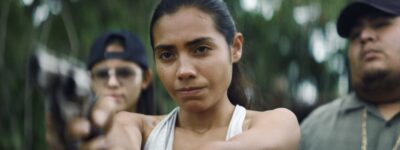The intense drama Cadejo Blanco follows a working-class girl from Guatemala City who travels to a small coastal town hoping to infiltrate a gang and find her sister, who has gone missing. Writing in the Austin Chronicle, film critic Ali Juell called the film “a vivid and multi-dimensional story as the audience sees Sarita join Andrés’ gang…Cadejo Blanco provides international audiences with a perspective they would largely be unexposed to otherwise and confronts some of the issues facing Guatemalans today.” Demetrios Matheou of Screen Daily described the film as “a nail-biting, evocative and utterly persuasive crime drama that is very much a part of the country’s burgeoning film output.” We open the film on Friday, April 21 at the Laemmle NoHo.
Writer-director Justin Lerner wrote the following about the creation of the film:
Guatemala has been my second home since 2016 when I moved there to help start a film school in the capital. The development of Cadejo Blanco began a year after I arrived, when I visited Puerto Barrios, a picturesque port city on Guatemala’s northeast Caribbean coast. I was invited by one of my students, an aspiring filmmaker, who wanted to discuss the possibility of making a movie together in his hometown. While he spent days showing me possible filming locations, I was introduced to many young men and women involved in “clicas,” small disorganized gangs of young people who engage in illegal activity (robberies, drug dealing, violence, and sometimes murder) in order to survive and to make money.

Over the course of the next two years, I formed friendships with present and former members of these clicas. I interviewed dozens of them (some who were very open and let me record our talks, and others who would only talk off the record). I toured their neighborhoods, homes, and hidden places of business (called ‘safe houses’), and I even got to know some of their families.

At one breakfast I was invited to, I sat next to a funny and charismatic man who I later discovered was a professional hitman. Inspired by all the stories told to me by the young people I’d met, I put together a feature screenplay about a teenager from the capital, Sarita, who comes to Puerto Barrios in search of her missing sister. Sarita tracks down her sister’s ex boyfriend, Andrés, who is a gang member in Puerto Barrios. Positive that Andrés has something to do with her sister’s disappearance, Sarita uses a fake name and finds a way to join his clica, hoping to learn more about what happened.

Watching the news at my hotel, I was astounded by the regularity of reports of girls who had gone missing, last seen on a bus that had been robbed or taken from their houses in the middle of the night. But I also learned that unlike in other parts of Central America, where women are often relegated to selling drugs or sex, women in Puerto Barrios clicas can be given a great deal of power.
In writing the screenplay, I relied heavily on real experiences related to me by a few young women affiliated with Puerto Barrios gangs. They opened up about the dangers of being a woman forced to join a clica to survive in a city with very few opportunities. They’d lost friends and family members to violence and crime and seen other female friends disappear right after joining.
Once a full draft was finished, Mauricio Escobar introduced me to Guatemalan filmmaker César Díaz, who won Cannes Film Festival’s 2019 Critics Week Prize and Camera d’Or for his film NUESTRAS MADRES (OUR MOTHERS), and he advised me through rewrites of the script, lending his perspective as a Guatemalan filmmaker, and helped me shape the film in post as my editing partner. He also served as an Executive Producer.
Early in pre-production, I met Rudy Rodríguez, a twenty-one year old who responded to a open call, coming in on his lunch break from the auto shop where he worked. In his audition, Rodríguez, a non-actor with a history of gang involvement, spoke openly about his former affiliations with gangs in Puerto Barrios, the infant daughter he just had with his girlfriend, and the significance of the tattoos he had on each shoulder, black-inked stars, which he got to remember his deceased mother and murdered father.
When I decided to cast Rodríguez as Andrés, the film’s male protagonist, I planned out several trips back to Puerto Barrios to spend more time with him. I brought our lead actress, Karen Martínez, who I’d cast after long admiring her work in the film LA JAULA DE ORO. With the help of Tatiana Palomo, an acting coach who studied at Carlos Reygadas’ film school in Mexico and specializes in training non-professional actors to perform on film, Karen and I worked with Rodriguez to help him feel comfortable on camera.
My Guatemalan lead producer, Mauricio Escobar of La Danta Films, was able to help establish a partnership between the film and Movimientos de Esperanza, an NGO based in Puerto Barrios, who partially sponsored Rudy’s experience working on the film. Through donations, the NGO was able to bring Rodríguez to the capital to live for months before the shoot, to train with me and Tatiana Palomo. The NGO was also able to provide Rodríguez with psychological and financial counselling through the duration of pre-production and production.
The rest of the casting process lasted for two more years and involved months of meeting locals at youth centers, churches, schools, and parks. I also sought the direct participation of current and former gang members who I had done interviews with previously, offering some of them significant roles in the film playing versions of themselves. For over a year leading up to the actual shoot, I conducted workshops and rehearsals aimed at making them feel comfortable improvising on screen.
Once I had a shareable draft of the script in Spanish, I shared it with certain members of the non-professional cast and asked them to rewrite it with me, so that each scene would fit each performer’s own voice and the film would maintain authenticity to their city. I encouraged each of them to revise the script as they saw fit, even during shooting. It was a process that caused delays, and even arguments, but it helped to ensure that the realities of their lives were being properly represented on screen.
I also added a handful of professional actors from Guatemala City to the supporting cast. Brandon López, Karen Martínez’s co-star in LA JAULA DE ORO, who shared the same award at Cannes and also won an Ariel award for his performance in that film, was the only trained actor to be cast as a gang member. He led my rehearsals with the non-professionals from
Puerto Barrios, also serving as their on-set acting coach. They looked up to him, having seen him in films, and on YouTube. Juan Pablo Olyslager, who I had seen in Jayro Bustamante’s films TEMBLORES and LA LLORONA, and veteran theater actress Yolanda Coronado, were also cast in supporting roles.
After seeing the film COCOTE at a film festival, I tracked down the cinematographer, an Argentinian named Roman Kasseroller and shared an early draft of the script with him. He agreed to work on the film, and within a few months he was able to meet me in Guatemala. As we scouted locations in Puerto Barrios, Roman met most of the locals I had cast. To get them comfortable with Roman putting a camera in their faces and being around the approximation of a crew, we staged several photo shoots and even filmed a scene from the script on a digital SLR.
Throughout the development process, I would periodically return to Los Angeles to share footage with producer Ryan Friedkin of Imperative Entertainment, who provided script and casting notes, advice and helped with strategy to get the film fully financed. Once we cast all the roles and finalized the script, Friedkin brought on producer Jack Hurley from The Orange
Company, who put together the rest of the financing with Escobar of La Danta Films.
A few months after the shoot, one of the Puerto Barrios cast members, Geobanny Alvarado, was tragically murdered. Most details of his death are unknown, but he was a valuable contributor to the film, having spent months with the crew, helping us find shooting locations, as well as offering revisions to the script, not only for his own dialogue, but for other parts of the screenplay that took place in Puerto Barrios.
The film will be dedicated to Alvarado’s memory, to honor the significant role he played in the project, both on screen and off. The NGO Movimientos de Esperanza, in partnership with the film, will also be securing a number of financial scholarships and work opportunities for the actors. They will be presented in Alvarado’s name.
One of the small hopes I have for those who watch Cadejo Blanco is that they will be able to feel like they got to live in Puerto Barrios for a few hours. I also hope that in watching the film they felt they got to know Alvarado, and his cast-mates, and will miss spending time with them when the film is over, as I do.
Justin Lerner, writer-director, Cadejo Blanco
